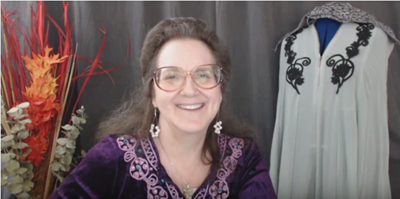Is Samhain’s Ancient Past Seen In Modern Halloween Observances?
 The festival of Samhain (literally “summer’s end” – pronounced Sow-en) represents literally millennia of observance and standing among the Celtic peoples of Northern Europe. Samhain was the traditional time when the earth died and rested, to be reborn with the warmth of the spring. It was the time of year when the Cailleach (the veiled woman), the old woman goddess began to hold sway. However, did you know that of Samhain of old is responsible for much of our Halloween fun?
The festival of Samhain (literally “summer’s end” – pronounced Sow-en) represents literally millennia of observance and standing among the Celtic peoples of Northern Europe. Samhain was the traditional time when the earth died and rested, to be reborn with the warmth of the spring. It was the time of year when the Cailleach (the veiled woman), the old woman goddess began to hold sway. However, did you know that of Samhain of old is responsible for much of our Halloween fun?
The Night Before: The Ancient Celts began their observances of Samhain beginning at sundown on the eve of Samhain. The day before the festival hearth fires were extinguished and hearth and home cleaned getting rid of the old and making way for the new. At sun down communal bonfires were lit to begin the ceremonies. Crops and animals were offered as sacrifices to the Gods and Goddesses while the cleansing fires were believed to burn out the old year and make way for the new.
Three Good Reasons To Wear A Costume: The idea of wearing costumes goes back literally thousands of years. The Celts wore costumes and danced around communal bon fires. Many of the dances were stories that played out the cycle of life-death-and-rebirth. Today you may wear that smokin’ hot outfit to catch a special someone’s eye, but originally Samhain costumes were for religious reasons.
Honor! Honoring the dead and those allowed to rise from the Otherworld. Samhain was/is believed to be the night that souls are released by the Lord of the Dead to go on to their new incarnations. It is thought that the wearing of costumes was to signify the releasing of these souls back into the world of living man.
Fear! (Spooky Boo!) Not all released spirits were considered benevolent; in fact, some were seen as downright malevolent. The bad spirits were feared because they were believed to have negative impacts on the living by doing such things as hiding livestock, destroying crops, or haunting the living who had harmed them. Wearing a costume allowed the Celt to hide from the malevolent spirits.
“Holiday” Best! Do you remember having to get dressed up to attend church, temple, synagogue, or mosque? Well, the same theory applies. The Celts wore costumes to honor the Gods and Goddesses for the blessings of the past year and for the new year to come. By giving thanks and homage to these deities, the Celts were hoping to ensure their favor and protection for the winter and year to come.
The Veil. The Celts believed there was a thin veil between the world of the living and the Otherworld. Samhain was the night in which that veil was the thinnest and/or lowered, allowing for communication between the living and the dead. (This is why Samhain is one of the best times of the year to get a psychic reading!) Some cultures sought protection from this releasing of spirits in a variety of ways.
One was by leaving a light on the door stoop all night. For early peoples this was a little more difficult than just leaving the porch light on. The lamps or lights were put inside hollowed out gourds and believed to light the way for souls and spirits. This practice is believed to be the ancient beginnings of our modern Jack-o-Lantern.
Following an evening of revelry and observances, the families would bring a burning ember or torch from the bonfires home with them to light the New Year’s fire in their hearth. This symbolic transference of the flame of the sacred bonfire to the hearth was believed to help protect the dwelling and the family throughout the long winter. Hearth fires were kept burning throughout the winter months to ensure good luck. If a family lost their hearth fire, it was believed to be a sign that tragedy and woe were not far away.
Once the home’s hearth was well lit and burning, the family would place food and drink outside their door as protection against the spirits wandering at night. It was believed that by leaving food and drink the family was protecting themselves against the spirits who might take vengeance on the family by playing tricks on them.
So, however you celebrate Halloween, you can thank the Celts! Before their Samhain holiday was borrowed by the Romans and converted by Pope Benedict to a Christian holiday one in the 800s the Celts had already laid down practices that are still observed in some way today – over 2000 years later.

